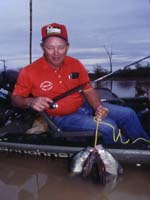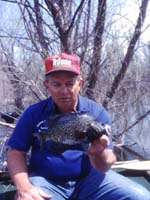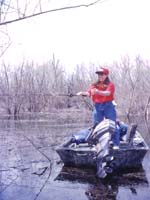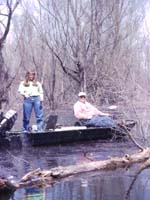
|
Features
|
|
|
|
Books
|
|
|
|
Fun & Games
|
|
|
|
Contact Us
|
|
|
Night Hawk Stories... Entry 32
The Crappie Dawg And The Pup
by John E.
Phillips
Page 1
 For
more than 30 years, Ed "Dawg" Weldon has pulled slab crappie from the
Tunica Cut-off, an oxbow lake just off the Mississippi River near Tunica,
Mississippi. Ed Weldon can find crappie like a bird dog pinpoints quail
and catch them too. He uses secret baits and tactics that produce slabs
almost every time he goes out.
For
more than 30 years, Ed "Dawg" Weldon has pulled slab crappie from the
Tunica Cut-off, an oxbow lake just off the Mississippi River near Tunica,
Mississippi. Ed Weldon can find crappie like a bird dog pinpoints quail
and catch them too. He uses secret baits and tactics that produce slabs
almost every time he goes out.
The "Dawg" also has a running buddy, the "Pup," who has
the same nose for crappie that Dawg does, but who uses different techniques
to catch crappie in the early spring. Let's see what makes the Dawg and
the Pup crappie fishing's deadly duo.
The Dawg's Tackle
"I use a B'n'M jigpole because it's made of graphite and very sensitive," Dawg Weldon stated. "I want the sensitivity of the graphite so I can feel the crappie bite, but the pole has got to be strong enough to lift a 2-pound crappie over the gunwales of the boat."
Weldon fishes either 6- or 8-pound-test Berkley Vanish line or Berkley XL. "I prefer a limp monofilament when I'm fishing in the brush," Dawg explained.
 On
the end of the line, Dawg ties a Quick Snap, a question-mark-shaped snap
that allows him to put on and take off jigs quickly. He can change the
size of his jig or the color of his jig without having to tie a knot.
More importantly, the Quick Snap allows the jig to fall vertically. Weldon
believes that a vertical presentation of the jig produces more strikes
than when the jig falls head- first or tail-first.
On
the end of the line, Dawg ties a Quick Snap, a question-mark-shaped snap
that allows him to put on and take off jigs quickly. He can change the
size of his jig or the color of his jig without having to tie a knot.
More importantly, the Quick Snap allows the jig to fall vertically. Weldon
believes that a vertical presentation of the jig produces more strikes
than when the jig falls head- first or tail-first.
"I like a 1/16-ounce maribou tail jig with Berkley's Nibbles on the hook up near the head and a live cricket attached to the bottom part of the hook," Weldon commented.
"I prefer fishing with the Berkley Crappie Nibbles because they put off scent in the water. Many times when crappie tend to be hush-mouthed, I believe that scent turns them on and makes them bite."
 Dawg
Weldon, primarily a bream fisherman early in his fishing career, often
noticed that when he fished for bream with crickets, he frequently would
catch crappie. He decided that he didn't have to give up one style of
fishing for the other. "Bream will hit a crappie jig as quick as a crappie
will," Weldon emphasized. "But a bream won't hit the jig as quickly if
the jig doesn't have another bait on it. So, I put the crickets on the
ends of my jigs to catch both crappie and slab-size bluegill. Most crappie
fishermen don't know that crappie won't turn their noses up at crickets.
I believe I catch twice as many crappie using crickets on the ends of
my jigs as an angler does who fishes only with a jig and no cricket."
Dawg
Weldon, primarily a bream fisherman early in his fishing career, often
noticed that when he fished for bream with crickets, he frequently would
catch crappie. He decided that he didn't have to give up one style of
fishing for the other. "Bream will hit a crappie jig as quick as a crappie
will," Weldon emphasized. "But a bream won't hit the jig as quickly if
the jig doesn't have another bait on it. So, I put the crickets on the
ends of my jigs to catch both crappie and slab-size bluegill. Most crappie
fishermen don't know that crappie won't turn their noses up at crickets.
I believe I catch twice as many crappie using crickets on the ends of
my jigs as an angler does who fishes only with a jig and no cricket."
Weldon has specific ideas about how to attach the live cricket to the hook. "You can't just put the cricket on the jig any old way and expect it to catch crappie," Weldon commented. "I put the point of the hook under the cricket's throat and move it toward the tail of the cricket. But I don't want the barb to come out of the cricket. I just use the cricket to help hide the hook. When you put a cricket on a jig this way, the cricket drops vertically just like the jig does, and the bait looks more natural."
Oxbows And Hairy Willows For Big Slabs
Weldon believes that anytime you find oxbow lakes off a main river system you'll often locate prespawn and spawning crappie in them. These oxbows usually warm up quicker than the main river does and generally contain better spawning structure than the main lake will.
 The
Tunica Cut-off homes numbers of willow trees. "The Tunica Cut-off is loaded
with willow trees that have grown up on the ridges in this oxbow," Weldon
explained. "The hairy willows, especially, are ideal habitat for crappie."
The
Tunica Cut-off homes numbers of willow trees. "The Tunica Cut-off is loaded
with willow trees that have grown up on the ridges in this oxbow," Weldon
explained. "The hairy willows, especially, are ideal habitat for crappie."
When I came home from fishing with Weldon, I looked up "hairy willows" in my botany book and couldn't find any such tree. When I called Weldon back and asked, "What's a hairy willow?" Weldon replied, "a hairy willow is a willow that's been cut down and only the stump left. The stump begins to regenerate, displaying many new shoots and sprouts growing from the stump. In the middle of a hairy willow is a hole that is really the top of the stump where big crappie will often hold and attack baitfish that swim on the outside of the young growth."
Most crappie fishermen won't cast or drop their minnows or jigs through or over the top of the hairy willows to get to the bigger crappie, but that's where they hold and how Weldon catches them. Other species also hold inside the hairy willows. Weldon often catches bass, bluegills and catfish using this same technique and fishing at the center of the hairy willows.